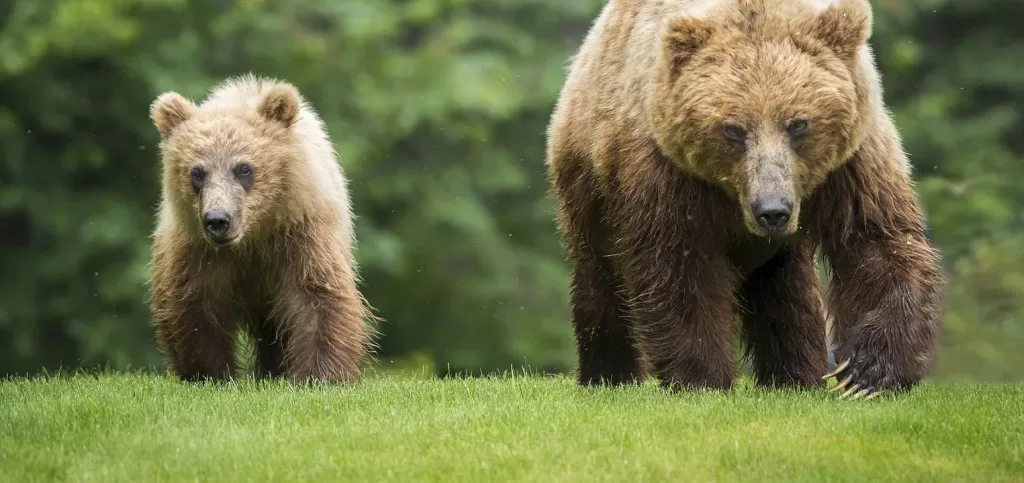Updated 2024 Population Figures Highlight Growth and Ongoing Challenges
The brown bear (Ursus arctos) has been making a cautious comeback in Spain over the last two decades. Two geographically isolated populations—the Pyrenean brown bear and the Cantabrian brown bear—are following different conservation paths. New data from 2024 reveals progress in both regions, alongside some pressing genetic and ecological concerns.
Pyrenean Brown Bear Population Reaches 83 (or 96)
The Pyrenean population now includes at least 83 bears, with 16 cubs born in the 2022–2023 winter, according to monitoring agencies in France and Spain. These bears are distributed across France, Andorra, and the Spanish regions of Catalonia, Aragon, and Navarre.
(Some sources are stating upwards of 96 individuals, including cubs from 2024)
Read the full article and see more statistics in English here.
Genetic tracking shows that 47 individuals currently roam the Catalan Pyrenees alone. This marks a major improvement from past decades when the species was nearly extinct in the region.

Listen to the podcast about the Brown Bear Populations in Spain: Pyrenean Recovery and Cantabrian Stability
Inbreeding Risks and Genetic Bottlenecks
Despite the growth, genetic diversity is a major concern. Most bears in the Pyrenees descend from a single male named Pyros, a Slovenian bear introduced in the 1990s. His dominance has led to inbreeding, raising questions about the long-term health of the population.
Proposals to introduce unrelated bears have sparked debate, especially among local farmers and rural communities affected by livestock predation. “Despite an encouraging growth in numbers, France’s national biodiversity body has warned that the long-term survival of brown bears in the Pyrenees nonetheless remains uncertain. “Read more here.
Cantabrian Brown Bear Numbers Surpass 400
In the Cantabrian Mountains, the brown bear population has made a more stable and genetically diverse recovery. From a low of just 60–70 individuals in the 1980s, the population now stands at over 400.

This population inhabits Asturias, León, Cantabria, and parts of Galicia. Unlike in the Pyrenees, the recovery here involved no reintroduction of foreign bears. Instead, conservation focused on habitat protection, anti-poaching measures, and public awareness.
Read a bit more about the Cantabrian brown bear here: https://wildsideholidays.co.uk/the-brown-bear-population-in-the-cantabrian-mountains-facts-and-controversies/
A Native Population With Natural Recovery
Cantabrian bears are entirely native and retain greater genetic diversity. There are still two main subpopulations (eastern and western), but increasing movement between them is helping reduce fragmentation.
Key Differences Between Pyrenean and Cantabrian Brown Bears
Here are the main distinctions between the two populations:
Population size (2024)
- Pyrenean: 83 (96?) individuals
- Cantabrian: 400+ individuals
Geographic range
- Pyrenean: France, Spain (Navarre, Aragon, Catalonia), Andorra
- Cantabrian: Northern Spain (Asturias, León, Cantabria, Galicia)
Origin
- Pyrenean: Reintroduced (mostly Slovenian origin)
- Cantabrian: Native population
Genetic diversity
- Pyrenean: Low, high inbreeding risk
- Cantabrian: Higher, more balanced
Conservation focus
- Pyrenean: Genetic reinforcement needed
- Cantabrian: Continued habitat protection and corridor creation
Human conflict
- Pyrenean: Higher due to livestock issues
- Cantabrian: Lower, but growing with expansion
Conservation Outlook: Collaboration Is Key
Both populations show how targeted conservation can reverse decades of decline, but their futures depend on different priorities.
- In the Pyrenees, cross-border cooperation between France, Spain, and Andorra is critical to managing genetic risks.
- In the Cantabrian Mountains, focus remains on maintaining wild corridors and preventing new fragmentation.
Efforts must continue to ensure these bears remain a permanent part of Spain’s natural heritage.
Ronda Today
Everything you need to know before you visit Ronda “The city of dreams” in Andalucia. https://www.rondatoday.com/
Visit Cádiz
Planning on visiting Cádiz? Tourist information. Monuments. Hotels. Activities. City guides: https://visitingcadiz.com/
The Caminito del Rey
Find tickets for the Caminito del Rey: https://www.caminodelrey.es/
Wildside Holidays
Take a trip on the Wildside! Discover the wildlife and nature of Spain, its Natural and National Parks and find the top wildlife, activity and walking holiday companies.
Iberia Nature Forum
Struggling with identifying those bugs and beasties? Why not check out the Iberia nature Forum! https://iberianatureforum.com/
I’ve been living in this lovely area of Western Andalucia for the last 20 years or so and dedicate most of my time to the running of English language tourist information websites for the towns of Cádiz, Ronda, Grazalema, the famous or infamous Caminito del Rey, and also Wildside Holidays, which promotes sustainable and eco-friendly businesses running wildlife and walking holidays in Spain. My articles contain affiliate links that will help you reserve a hotel, bus, train or activity in the area. You don’t pay more, but by using them you do support this website. Thankyou!